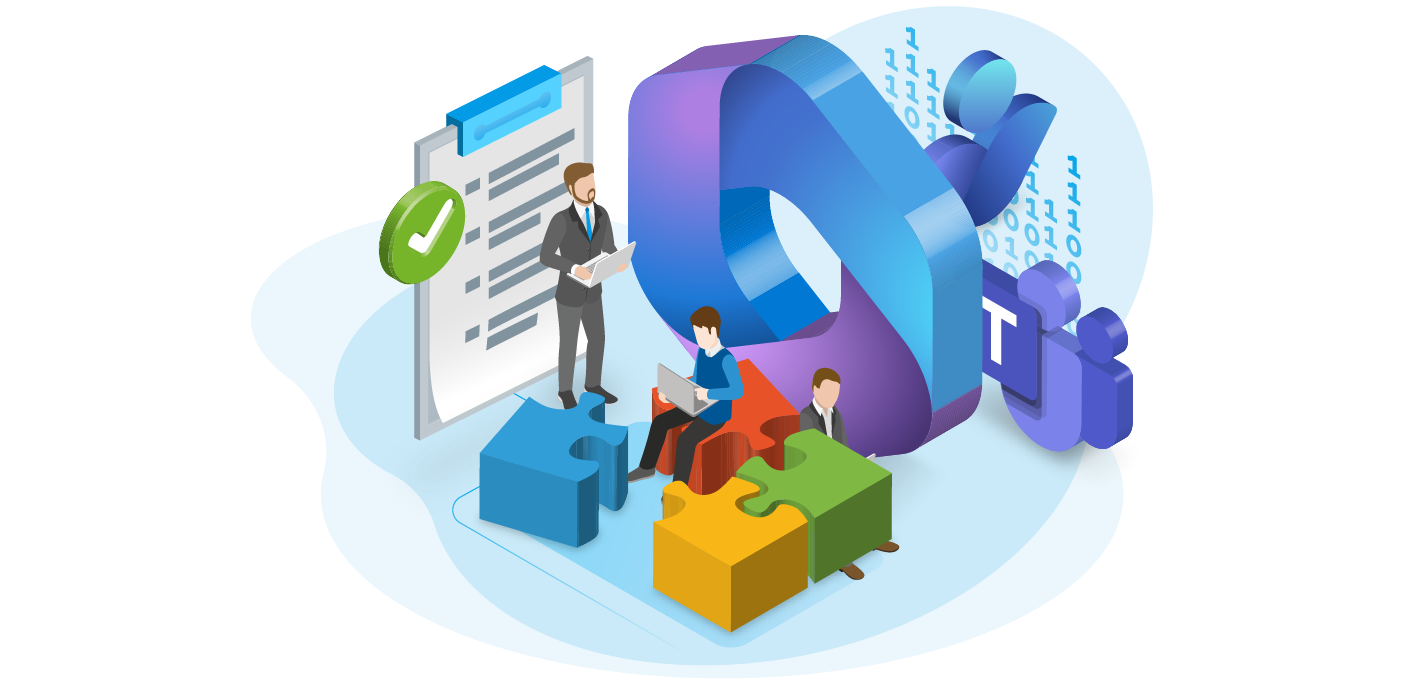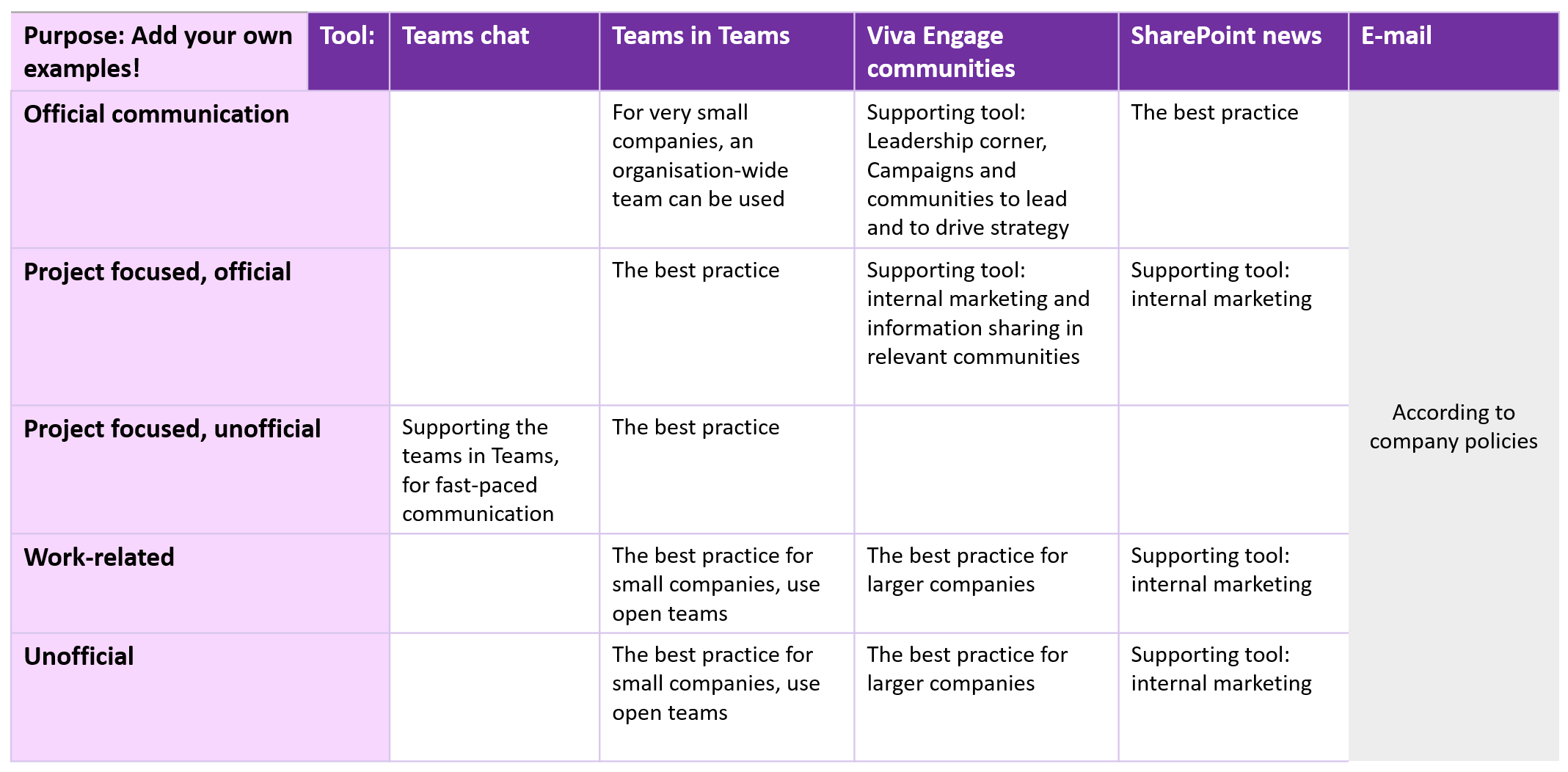Organisations have different needs and tools for communicating about official news, fostering discussions around themes and topics, driving strategy, and sharing information within teams and projects. In Microsoft 365 alone, we have several communication tools, including Outlook (e-mail), SharePoint (intranet), Teams and Viva Engage (ex-Yammer). What tool to use when? What are the best practices for different use cases and different sizes of companies? This article gives you a simple framework and concrete tips for positioning your communication tools.
Simplicity is the key
The sheer number of messages, bits of information, and pieces of news we send and read daily is enormous. The ways and amount of communication in the workplace have been rising since the pandemic. While Microsoft gives us the freedom to use our communication tools in varying ways, for most organisations and employees, it’s just too much. Our fast-paced work life needs simple guidelines: what message goes where.
What and to whom?
Let’s look at different forms of communication at a workplace based on the purpose and the audience. “Communication” can be a page in the intranet or a message in different tools. It is usually a written text, but communication can also be a voice mail, video or just a simple picture. To keep things simple, I have ruled out document management and physical communication such as meetings. This list might not cover all of your use cases – use this as a base and add your own!
Official communication
Official news and information about the company, usually written by the communications department or support functions such as HR or IT. This communication is generally aimed at everyone at the organisation, a certain location, or a certain role. Stored and archived for months or years.
Project-focused, official communication
Official information about projects, products, goals or assignments you work on alone or with a team. Instructions, questions, answers and discussions to get the job done. Usually relevant for days, weeks or even longer.
Project-focused, unofficial communication
Chats and fast-paced communication about projects and work which is only relevant in the current moment. This can be aimed at the whole team, a project group, or only certain team members.
Work-related, open communication
Discussions of themes and topics in the workplace which are interesting to people across the organisation, not tied to a single project or a team. For example: sharing interesting articles on sustainability, gathering together all the AI people in the organisation, or creating a learning group for Power Apps.
Unofficial communication
Chats and water-cooler-type discussions about lunches, pets or hobbies. All those non-work-related things help to build a community and sense of belonging. Do you think this is not suitable or important for a workplace? Think again. Studies show that employees with good relationships at work are more engaged, more productive and stay at the workplace longer. Taking those micro-breaks to have fun at work really pays off.
Organising our toolbox
Now we’ve cleared out different forms of digital communication at the workplace, it’s time to dive into the vast communication toolset at Microsoft 365.

Organisations are different – they work in very different fields, with various regulations and communications needs, and they can be anything from ten people startups to half-a-million-employee corporations. Does one size fit them all? There are a few different recommendations regarding especially open and closed groups in Teams and Viva Engage and individual guidelines with e-mails.
SharePoint
Let’s start with the simplest one. SharePoint intranet is the place to publish official news. This information can be company-wide or targeted to a specific location or role. In small companies, the intranet can be a few pages and a piece of news now and then – but SharePoint is flexible enough to be a full-blooded communication system for the largest of organisations as well.
Suppose you want employees to be able to comment and discuss the news. In that case, you can use the comment web part in SharePoint or make an automation to publish the news in the relevant groups in Teams or Viva Engage, where the discussion can then continue. You could even build a web part to show that discussion feed on the news page!
Teams
Teams is the most versatile tool in our box, and it’s also the hub for teamwork – the hub where you can also find your SharePoint intranet and Viva Engage. Luckily, positioning Teams can be simple. You just have to understand the different ways of communication in Teams and define the purposes for each. These definitions are best practices for many customers and are a good starting point for any company struggling with understanding Teams’ different capabilities.
Teams chat is the oldest of them all, deriving a long way back from Lync and Skype. It’s also the most familiar, which makes it usually overused against teams in Teams. The best practice for 1-1 and group chats in Teams is to position them for an ongoing and chat-like flow around current events. They are only relevant at that point in time and don’t need to be dug up later on.
Teams channels are for work. That’s your workplace, your team. Teams channels are usually private, created for a restricted group of people in a specific team or working together on a project. You can also collaborate with external partners in Teams with shared channels!
How about those open and organisation-wide teams in Teams? For smaller organisations, up to 200-300 people, open teams could be utilised the same way as open communities around themes in Viva Engage. The general tipping point is that when you realise you don’t know everyone in your organisation – then it’s the time to launch Viva Engage in addition to Teams. For even smaller organisations, up to 100 people, you could use an org-wide team for company-wide communications. For larger organisations, the simplest way is to define Teams for closed groups only, to use Viva Engage for open groups, and to keep the official communications in SharePoint.
Viva Engage
Viva Engage is an excellent rebranding of the good ol’ Yammer. The purpose of Viva Engage is to engage people across the organisation. It’s the place for sharing information and discussing topics and themes across the organisation. Those themes can be related to work, or they can be more about hobbies and free time. With new features like the Leadership Corner, Campaigns, and Viva Amplify, Viva Engage is also a powerful tool to lead, drive strategy and implement company-wide initiatives.
You can have open or closed communities in Viva Engage. To encourage breaking silos and active discussion, push open communities policy. I suggest not using the chat in Viva Engage for anything. Just forget it even exists.
This one may be the most complex of them all. E-mail is still a powerful tool in all communications, which is one of the main reasons people get confused. The information – and documentation! – scatter around private e-mail inboxes as well as all the other communication channels, making our toolbox a mess again. While I know several small and large companies that have made a successful decision not to use e-mail in any internal communications, I also know it’s not that simple. I would still recommend limiting internal e-mails to only specific use cases: for example, legal or HR reasons.
How does this all come together: The Positioning Chart
This is an example based on best practices. The key is to make things straightforward for the employees and use only one tool for one purpose.

Take this chart as an example, and build your own according to your company size and use cases. After you have the guidelines in place, you can start the actual work: adoption – but that’s a story for a whole other blog post!
Conclusion
Before you can envision the future, you need to know the current state: what tools employees use right now. It’s easy to get an overview of the amount (and trend!) of messages in different tools and channels with Microsoft 365 admin centre reports. You can also use a governance tool with declutter abilities such as in Rencore. You’ll be amazed how many teams without owners, SharePoint pages with no readers and abandoned Viva Engage communities there is. A proper manual or automated clean-up of orphaned teams and groups is a great starting point for your positioning work.
This article was written by a human 100%; no AI was involved. The categorisations are examples and best practices, not official documentation by Microsoft.
Merken




